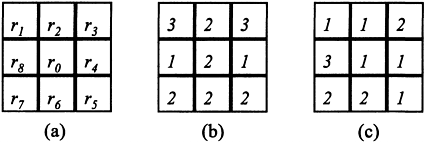177.
| [Cover] [Contents] [Index] |
Page 257
question of deriving estimates of parameters is a relatively new research field. Methods of parameter estimation can be divided into supervised and unsupervised. Supervised methods are based on the assumption that the image only contains one type of MRF pattern (i.e. MRF texture), or that the image contains several MRF patterns, but we know exactly where the boundaries between those MRF patterns are located. In other words, the classes (MRF patterns) in the image are known. We can then use training data selected from each class to perform parameter estimation.
Unsupervised methods are designed to cope with the situation in which we do not have any a priori idea about how many MRF patterns are contained in the image. A general strategy is to perform image clustering and parameter estimation alternatively. Like traditional clustering algorithms, unsupervised methods are run in an iterative mode, but are more sophisticated. One supervised approach, the least-squares fit (Derin and Elliott, 1987), is introduced below. For details of other supervised approaches, refer to Chandler (1987), Parisi (1988) and Saguib et al. (1998). For unsupervised estimation, refer to Dempster et al. (1977), Besag (1986), Wahba (1990), and Reeves (1992).
6.4.1 Least-squares fit method
The least-squares fit (LSF) is a method which uses a regression technique to obtain estimates of Markovian parameters. The LSF method was proposed by Derin and Elliott (1987), who demonstrate that parameter estimation using LSF is more accurate than some other approaches (e.g. the method proposed by Besag (1974)).
For clarity, we consider a problem involving clique type c=2. There will be four clique potential parameters (i.e. β1, β2, β3, and β4, as shown in Figure 6.2) to estimate. Define a vector θ, θ=[β1, β2, β3, β4]T, and consider a 3×3 window centred on the pixel r0, as shown in Figure 6.15a. The potential function for pixel r0 is defined as (see Equation (6.4)):

Figure 6.15 (a) 3×3 window centred on r0, and two possible configurations with three labels (1 to 3) shown in (b) and (c).
| [Cover] [Contents] [Index] |
EAN: 2147483647
Pages: 354